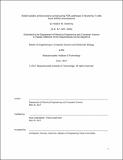Model studies aimed toward constructing PI3K pathways in leukemia T-cells from shRNA knockdowns
Author(s)
Sweeney, Heather M
DownloadFull printable version (1.882Mb)
Other Contributors
Massachusetts Institute of Technology. Department of Electrical Engineering and Computer Science.
Advisor
Arup Chakraborty.
Terms of use
Metadata
Show full item recordAbstract
Understanding the networks that regulate cellular processes, and how they are mis-regulated, is a major area of study. This is especially key in leukemia, where the complexity of the pathways involved and the heterogeneity between different leukemia cell strains makes it difficult to design therapies that are less vulnerable to deleterious side effects or compensatory mutations. However, despite their potential, methods to reconstruct networks are often specific to experimental technique and their exact ability to accurately capture networks is unexplored. Motivated by a shRNA knockdown experiment on leukemia cell lines treated with a PI3K inhibitor, we sought to devise and test a method to reconstruct the relevant network, which could be used to gain a deeper understanding of the networks involved in PI3K signaling in leukemia cells. We simulated a shRNA knockdown experiment on a known small network and tested an inverse Potts model for reconstructing the network based on correlations from the simulation output. We found the method did not infer the small network properly, but did produce several patterns that indicate it may have potential for revealing something of interest about larger systems. Understanding what the patterns convey about the system and devising a better method to see if that works are future steps that will allow us to see if we can apply this method to in vitro data.
Description
Thesis: M. Eng., Massachusetts Institute of Technology, Department of Electrical Engineering and Computer Science, 2017. This electronic version was submitted by the student author. The certified thesis is available in the Institute Archives and Special Collections. Cataloged from student-submitted PDF version of thesis. Includes bibliographical references (pages 38-40).
Date issued
2017Department
Massachusetts Institute of Technology. Department of Electrical Engineering and Computer SciencePublisher
Massachusetts Institute of Technology
Keywords
Electrical Engineering and Computer Science.